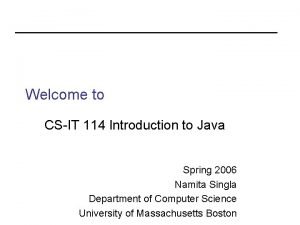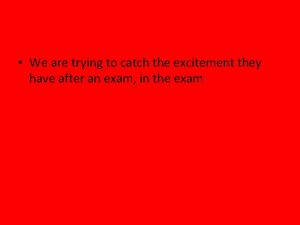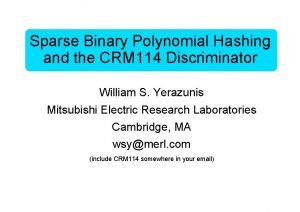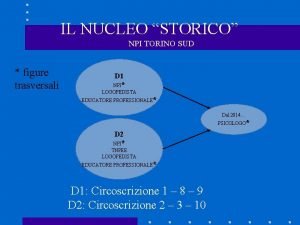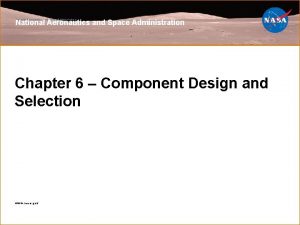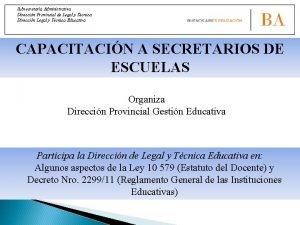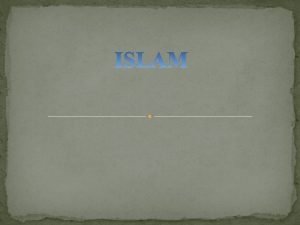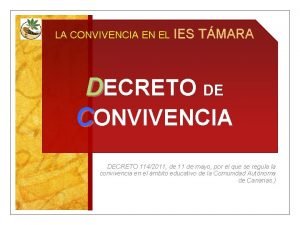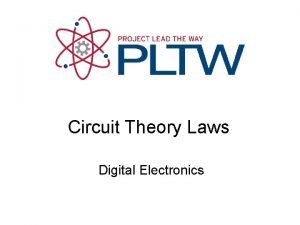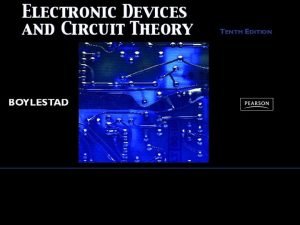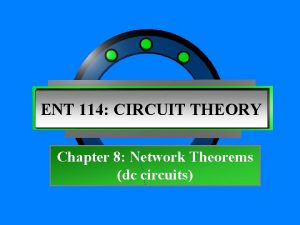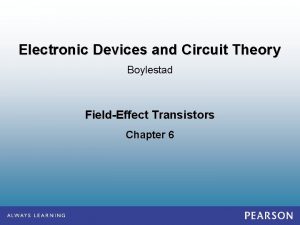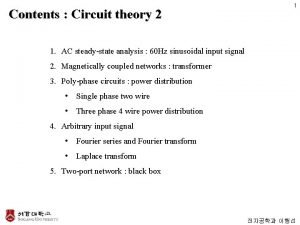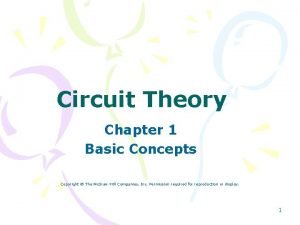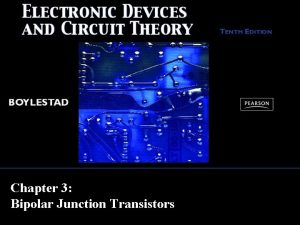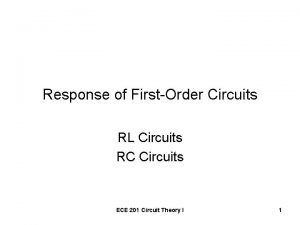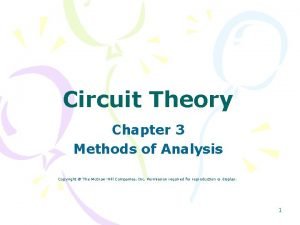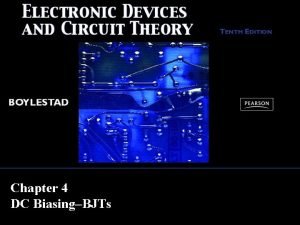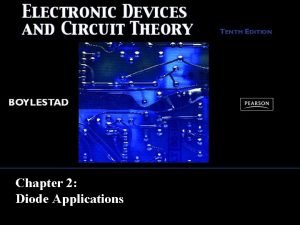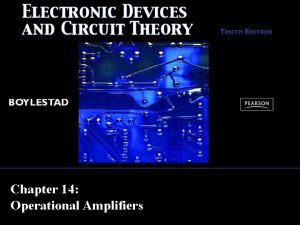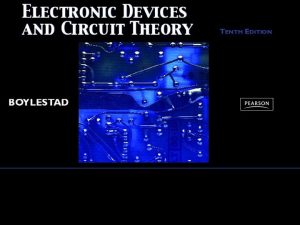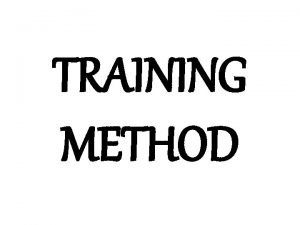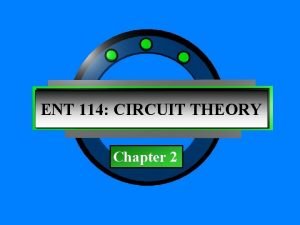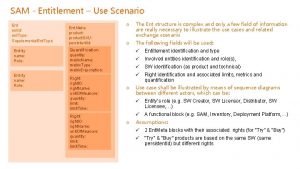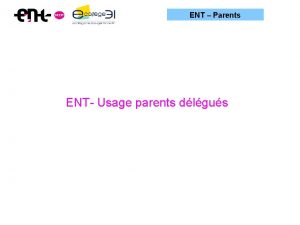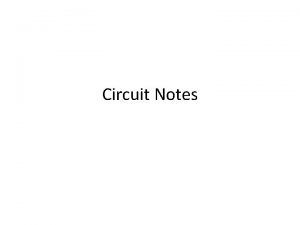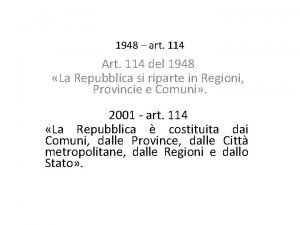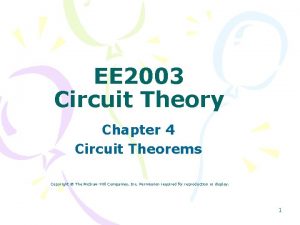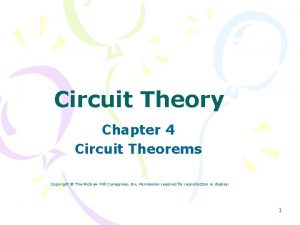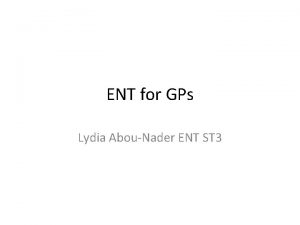ENT 114 CIRCUIT THEORY Chapter 7 Method of











































- Slides: 43

ENT 114: CIRCUIT THEORY Chapter 7: Method of Analysis (dc circuits)

Introduction _ Methods of analysis have been developed that allow us to approach in a systematic manner a network with any number of sources in any arrangement. _The methods covered include branch-current analysis, mesh current analysis and node voltage analysis.

Introduction • When two series element cannot be combined because they are different types of element, we need to use other approach to solve the problem. • The reduce and return approach cannot be used. • The approach are branch current analysis, mesh current analysis and node voltage analysis

Current Sources _ The current source is often described as the dual of the voltage source. _ A battery supplies a fixed voltage, and the source current can vary; but the source supplies a fixed current to the branch in which it is located, while its terminal voltage may vary as determined by the network to which it is applied.

Current Sources _A current source determines the current in the branch in which it is located _ The magnitude and polarity of the voltage across a current source are a function of the network to which it is applied

Example 7. 1 • Find the source voltage, the voltage V 1, and current I 1 for the circuit in Figure 7. 1

Example 7. 2 • Find the voltage Vs and currents I 1 and I 2 for the network in Figure 7. 2

Source Conversions _ An ideal source cannot be converted from one type to the other. _All sources – whether they are voltage or current – have some internal resistance. _ The equivalence between a current source and a voltage source exists only at their external terminals. _ A source and its equivalent will establish current in the same direction though the applied load.

Source Conversions

Current Sources in Parallel _If two or more sources are in parallel, they may be replaced by one current source having the magnitude and direction of the resultant, which can be found by summing the currents in one direction and subtracting sum of currents in the opposite direction. _The new parallel internal resistance is the total resistance of the resulting parallel resistive elements.

Example 7. 3 • Reduce the parallel current sources in Figure 7. 3 to a single current source.

Example 7. 4 • Reduce the parallel current sources to a single current source

Exercise 7. 1 • Reduce the parallel current sources to a single current source

Current Sources in Series _ The current through any branch of a network can be only single-valued. _ Current sources of different current ratings are not connected in series.

Branch-Current Analysis • Assign a distinct current of arbitrary direction to each branch of the network. • Indicate the polarities for each resistor as determined by the assumed current direction. • Apply Kirchhoff’s Voltage Law around each closed, independent loop of the network • Apply Kirchhoff’s Current Law at the minimum number of nodes that will include all the branch currents of the networks.

Determining the number of independent closed loops.

Determining the number of applications of Kirchhoff’s current law required.

Branch-Current Analysis _This method will produce the current through each branch of the network, the branch current. Once this is known, all other quantities, such as voltage or power, can be determined.

Branch-Current Analysis _ Steps required for this application 1. Assign a distinct current of arbitrary direction to each branch of the network 2. Indicate the polarities for each resistor as determined by the assumed current direction 3. Apply Kirchhoff’s voltage law around each closed, independent loop of the network 4. Apply Kirchhoff’s current law at the minimum number of nodes that will include all the branch currents of the network 5. Solve the resulting simultaneous linear equations for assumed branch currents

Example 7. 5 • Apply the branch-current method to the network Vs 1 Vs 2

Example 7. 5: Solution • Step 1: Assign branch current – Branch cda = I 1 – Branch cba = I 2 – Branch ca = I 3 Vs 1 Vs 2

Step 2: Inserting the polarities across the resistive elements as defined by the chosen branch currents. Vs 2

• Step 3: Apply KVL around each closed loop (1 and 2) in the clockwise direction.

• Step 4: Apply KCL at node a. • Step 5: There are 3 equations and 3 unknowns.

• In the matrix form the equation may be written: • Using Cramer’s rule we have

• Δ is the determinant of A and


• Solve the current


MESH CURRENT ANALYSIS + R 1 - + - I 1 R 3 - + Vs 1 + - + R 2 - I 2 + - Vs 2 1. Assign mesh current I 1, I 2 to the n mesh. 2. Indicate the polarities within each mesh for each resistor as determined by the assumed direction of mesh current for that mesh.

MESH CURRENT ANALYSIS + R 1 + I 1 R 3 - + Vs 1 + R 2 - I 2 + - Vs 2 3. Apply KVL around each mesh. • Apply KVL to Mesh 1 Substract since I 2 is opposite in direction to I 1

MESH CURRENT ANALYSIS + R 1 + I 1 R 3 - • + - + Vs 1 + R 2 - I 2 + - Vs 2 Apply KVL to Mesh 2 Substract since I 1 is opposite in direction to I 2

4. Solve the resulting simultaneous linear equation for the assumed loop currents.

Example 7. 6

Example 7. 6: Solution • Step 1 & 2: as indicated in the circuit • Step 3: KVL Loop 1: Loop 2:

Example 7. 6: Solution • Step 3: KVL Rewritten : Yield:

Example 7. 6: Solution • Step 4:

Example 7. 6: Solution • Since I 1 and I 2 are +ve and flow in opposite directions through 6 Ohm resistor and 10 V voltage source, the total current In the direction of I 2

SUPERMESH Step 1: Assign mesh currents

Step 2: The current source is removed, leave it as open circuit Step 3: Apply KVL to the resulting network 1

• Step 4: Apply KCL at node a 2 (1) + [2 x (2)]

MESH CURRENTS: Format Approach • Multiply the mesh current with the sum of all resistance around the mesh. • Subtract the product of each adjacent mesh current and the resistance common to both meshes. • Equate this to the voltage in the mesh. The sign being positive if the voltage source is in the same direction with the mesh current and vice versa. Mesh 1: Mesh 2:

Example 7. 7 Find the current through the 7 Ohm resistor Ans: I 2=-0. 971 A
 Pseudo color image processing
Pseudo color image processing Csit 114
Csit 114 Sas114
Sas114 Phys 250 ubc
Phys 250 ubc Taskj-114
Taskj-114 Who wrote psalm 114
Who wrote psalm 114 Po odparowaniu wody z 32 5 g nasyconego roztworu
Po odparowaniu wody z 32 5 g nasyconego roztworu Crm 114 discriminator
Crm 114 discriminator Asl via alassio 36 torino
Asl via alassio 36 torino Fact act section 114
Fact act section 114 Ppt-114
Ppt-114 Aiaa s-114
Aiaa s-114 Oesd 114
Oesd 114 Tercera estación del vía lucis
Tercera estación del vía lucis Hpd 133 uitm
Hpd 133 uitm Solicitud de licencia articulo 114 y 115 decreto 688/93
Solicitud de licencia articulo 114 y 115 decreto 688/93 Powstanie islamu
Powstanie islamu Decreto de convivencia
Decreto de convivencia Series vs parallel current
Series vs parallel current Two types of circuits
Two types of circuits Parallel circuit circuit construction kit
Parallel circuit circuit construction kit Parallel circuit vs series circuit
Parallel circuit vs series circuit Difference between complete circuit and incomplete circuit
Difference between complete circuit and incomplete circuit Diagram of short circuit
Diagram of short circuit Venn diagram of reflection and refraction
Venn diagram of reflection and refraction Pulmonary circuit and systemic circuit
Pulmonary circuit and systemic circuit Advantages of parallel circuit over series circuit
Advantages of parallel circuit over series circuit Introduction of symposium
Introduction of symposium Rl circuit
Rl circuit Circuit theory laws
Circuit theory laws Voltage in parallel circuit
Voltage in parallel circuit Electronic devices and circuit theory
Electronic devices and circuit theory Dc circuit analysis and network theorem
Dc circuit analysis and network theorem Jfet specification sheet
Jfet specification sheet Circuit theory 2
Circuit theory 2 Circuit theory basic concepts
Circuit theory basic concepts Electronic devices and circuit theory
Electronic devices and circuit theory Circuit theory
Circuit theory Circuit theory 3
Circuit theory 3 Load line analysis of transistor
Load line analysis of transistor Electronic devices and circuit theory
Electronic devices and circuit theory Electronic devices and circuit theory
Electronic devices and circuit theory Electronic devices and circuit theory
Electronic devices and circuit theory Circuit training
Circuit training

